J Bone Metab.
2014 Aug;21(3):189-194. 10.11005/jbm.2014.21.3.189.
High Dietary Sodium Intake Assessed by 24-hour Urine Specimen Increase Urinary Calcium Excretion and Bone Resorption Marker
- Affiliations
-
- 1Division of Endocrinology and Metabolism, Department of Internal Medicine, Samsung Medical Center, Sungkyunkwan University School of Medicine, Seoul, Korea. ykmin@skku.edu
- 2Health Promotion Center, Samsung Medical Center, Seoul, Korea.
- KMID: 2286288
- DOI: http://doi.org/10.11005/jbm.2014.21.3.189
Abstract
- BACKGROUND
The average dietary sodium intake of Koreans is 2.6 times higher than the World Health Organization's recommended amount. The effect of a diet high in sodium on the skeletal system, especially osteoporosis, has not previously been examined in Korean postmenopausal women with low bone mass. We assessed the daily sodium intake, and determined the impact of sodium intake on urinary calcium excretion and bone resorption marker.
METHODS
A retrospective review of medical records was performed for 86 postmenopausal subjects who were initially diagnosed with osteopenia or osteoporosis at the health promotion center. They were subsequently referred to the Division of Endocrinology and Metabolism between 2010 and 2013. All subjects completed a modified food frequency questionnaire. Twenty-four hour urine collection for sodium, calcium and creatinine excretion, and serum C-terminal telopeptides of type I collagen (CTX-I) were also obtained.
RESULTS
The average amount of daily sodium and calcium intake were 3,466 mg and 813 mg, respectively. Average dietary sodium intake and 24-hour urinary sodium excretion showed significant positive linear correlation (r=0.29, P=0.006). There was also a significant positive linear correlation between 24-hour urine sodium and calcium excretion (r=0.42, P<0.001); CTX-I and 24-hour urinary calcium excretion (r=0.29, P=0.007).
CONCLUSIONS
Excessive sodium intake assessed by 24-hour urine specimen is associated with high calcium excretion in urine. High calcium excretion is also related to increasing bone resorption marker.
Keyword
MeSH Terms
-
Bone Diseases, Metabolic
Bone Resorption*
Calcium*
Collagen Type I
Creatinine
Diet
Endocrinology
Female
Health Promotion
Humans
Medical Records
Metabolism
Osteoporosis
Retrospective Studies
Sodium
Sodium, Dietary*
Urine Specimen Collection
World Health
World Health Organization
Surveys and Questionnaires
Calcium
Collagen Type I
Creatinine
Sodium
Sodium, Dietary
Figure
Cited by 1 articles
-
Relationship between Decrease in Serum Sodium Level and Bone Mineral Density in Osteoporotic Fracture Patients
Mi Kyung Kwak, Dughyun Choi, Jae hyuk Lee, Hye Jeong Kim, Hyeong Kyu Park, Kyo Il Suh, Myung Hi Yoo, Dong Won Byun
J Bone Metab. 2015;22(1):9-15. doi: 10.11005/jbm.2015.22.1.9.
Reference
-
1. Ministry of Health & Welfare, Korea Centers for Disease Control and Prevention. Korea health statistics 2009: Korea national health and nutrition examination survey (KNHANES IV-3). Seoul: Ministry of Health & Welfare;2010.2. Looker AC, Borrud LG, Dawson-Hughes B, et al. Osteoporosis or low bone mass at the femur neck or lumbar spine in older adults: United States, 2005-2008. 2012. cited by 2014 May 10. Available from: http://www.cdc.gov/nchs/data/databriefs/db93.pdf.3. Centers for Disease Control and Prevention. Healthy people 2010: Arthritis, osteoporosis, and chronic back conditions. 2010. cited by 2010 May 10. Available from: http://www.cdc.gov/nchs/data/hpdata2010/hp2010_final_review_focus_area_02.pdf.4. Nordin BE, Need AG, Morris HA, et al. The nature and significance of the relationship between urinary sodium and urinary calcium in women. J Nutr. 1993; 123:1615–1622.
Article5. Zarkadas M, Gougeon-Reyburn R, Marliss EB, et al. Sodium chloride supplementation and urinary calcium excretion in postmenopausal women. Am J Clin Nutr. 1989; 50:1088–1094.
Article6. Ministry of Health & Welfare, Korea Centers for Disease Control and Prevention. Korea health statistics 2011: Korea national health and nutrition examination survey (KNHANES V-2). Seoul: Ministry of Health & Welfare;2012.7. Centers for Disease Control and Prevention. Sodium intake among adults - United States, 2005-2006. MMWR Morb Mortal Wkly Rep. 2010; 59:746–749.8. World Health Organization. Guideline: Sodium intake for adults and children. Geneva, CH: World Health Organization;2012.9. Kotchen TA, Cowley AW Jr, Frohlich ED. Salt in health and disease-a delicate balance. N Engl J Med. 2013; 368:1229–1237.10. Ministry of Health & Welfare, Korea Centers for Disease Control and Prevention. Korea health statistics 2007: Korea national health and nutrition examination survey (KNHANES IV-1). Seoul: Ministry of Health & Welfare;2008.11. Devine A, Criddle RA, Dick IM, et al. A longitudinal study of the effect of sodium and calcium intakes on regional bone density in postmenopausal women. Am J Clin Nutr. 1995; 62:740–745.
Article12. Audran M, Legrand E. Hypercalciuria. Joint Bone Spine. 2000; 67:509–515.
Article13. Kohlmeier M. Nutrient metabolism. 2nd ed. Amsterdam, NL: Academic Press;2006.14. National Health and Medical Research Council. Report of the working party on sodium in the Australian diet. Canberra, AU: Australian Government Publishing Service;1984.15. Garnero P. Markers of bone turnover for the prediction of fracture risk. Osteoporos Int. 2000; 11:Suppl 6. S55–S65.
Article16. Johnell O, Odén A, De Laet C, et al. Biochemical indices of bone turnover and the assessment of fracture probability. Osteoporos Int. 2002; 13:523–526.
Article17. Sabto J, Powell MJ, Breidahl MJ, et al. Influence of urinary sodium on calcium excretion in normal individuals. A redefinition of hypercalciuria. Med J Aust. 1984; 140:354–356.18. McParland BE, Goulding A, Campbell AJ. Dietary salt affects biochemical markers of resorption and formation of bone in elderly women. BMJ. 1989; 299:834–835.
Article19. Teucher B, Dainty JR, Spinks CA, et al. Sodium and bone health: impact of moderately high and low salt intakes on calcium metabolism in postmenopausal women. J Bone Miner Res. 2008; 23:1477–1485.
Article20. Dawson-Hughes B, Fowler SE, Dalsky G, et al. Sodium excretion influences calcium homeostasis in elderly men and women. J Nutr. 1996; 126:2107–2112.
Article21. Massey LK, Whiting SJ. Dietary salt, urinary calcium, and bone loss. J Bone Miner Res. 1996; 11:731–736.
Article
- Full Text Links
- Actions
-
Cited
- CITED
-
- Close
- Share
- Similar articles
-
- Calcium Status and Bone Mineral Density by the Level of Sodium Intake in Young Women
- Analysis of presumed sodium intake of office workers using 24-hour urine analysis and correlation matrix between variables
- Validity of Estimating Sodium Intake using a Mobile Phone Application of 24-hour Dietary Recall with Meal Photos
- Methodological issues in estimating sodium intake in the Korea National Health and Nutrition Examination Survey
- The relationship between urinary sodium excretion and bone mineral metabolism of climacteric women in Korea



